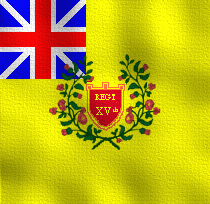
|
|
|
British Infantry by David Painter Infantry Organisation At the start of the Seven Years War, the strength of the British infantry stood at 3 Regiments of Guards and 59 regiments of infantry, each of a single battalion. In 1760 3 Regiments of Guards and 94 regiments of infantry by 1763 this had risen to 3 battalions of guards 124 battalions of infantry and 23 battalions of Highlanders. Each battalion was composed of 1 company of grenadiers and 9 companies of "musketeers". Later 1 company was converted in to light infantry. Each musketeer company was composed of 3 officers (1captain, 1 lieutenant and 1 ensign), 3 sergeants, 3 corporals, 3 drummers and 70 private soldiers (including 1 pioneer). The grenadiers; 4 Officers, 4 sergeants, 4 corporals, 2 drummers, 2 fifers and 100 grenadiers. On campaign the grenadiers of several battalions were grouped together or converged to for a temporary battalion of grenadiers commanded by the senior major, and known by his name. The Uniform The regulations for the uniform for the British army was laid down in "His Majesty's Warrant for the regulation of the colours, clothing etc. of the Marching Regiments of Foot" dated 1751. The coat was brick red in colour, collarless, reaching down to the knee; the tails buttoned back to expose the lining in the regimental colour. The lapels reached down to the waist also in the regimental colour with buttonholes trimmed with lace. The cuffs also in the regimental colour were deep enough to be turned down to cover the hand. The amount and type of lace varied from regiment to regiment depending on its colonel's tastes. Waistcoats were red having been cut down from the previous year's coat. Trousers were red for all except royal regiments (1st, 2nd & 3rd Foot Guards, 4th, 7th, 8th, 18th, 21st, 23rd and 41st) who wore blue. Gaiters black with black garters and uniform buckles and shoes. The hat was a black tricorn with white tape binding, 3cm's wide and a black cockade on the left-hand side. The Grenadiers The grenadiers were distinguished by their tall mitre caps, match cases and shoulder wings. Their hair was worn plated and tucker up underneath the cap.  The front plate of the cap was in the regimental colour decorated with the Royal cipher (GR) under a crown and over a red plate with a white horse and the motto "NEC ASPERA TERRENT" (Difficulties be dammed). In place of the Royal cipher, the Guards displayed the "Garter Star"; royal regiments their ancient badge. The Pioneers The Pioneers wore a leather apron and a round leather crowned cap, and was equipped with and axe and a saw. The Drummers and Fifers Drummers and fifers of the Royal regiments wore a red coat with blue trimmings and blue trousers; other regiments wore a coat and trousers in their regimental colour, the coat being trimmed with red. Long false sleeves hung down the back of the coat. They wore a cap made of cloth with a lower crown than that of the grenadiers. The front decorated with a motif of flags and drums. The Corporals Corporals wore an epaulet in white cord attached to the right shoulder. The Sergeants Sergeants wore a red woollen scarf tied around their waists and carried a halberd. The Officers Officers wore a similar uniform to their men (of much better quality), with shoulder cords of gold or silver on their right shoulder, a gorget hung around their neck and a crimson sash with a crimson and gold sword knot over their right shoulder. There didn't seem to be anything to distinguish between different ranks. They were armed with a spontoon, although many carried a fusil instead. The Generals There was no regulation uniform for Generals at this time. Equipment They were armed with the long land musket more commonly called the "Brown Bess". Cartridges were carried in a black cartouche hung from a cross-belt 7cm wide slung across the left shoulder. A knapsack or "read" bag hung from the right shoulder as did the sword or "hanger". Belts were white unless the regiment wore buff waistcoats, in which case the belts were also buff. The sword or hanger were curved for grenadiers and straight for others, about 68cm long, mostly used for cutting firewood. Drums The drums were made of wood, the front painted with the facing colour of the regiment, with the Kings cipher and crown and the number of the regiment. Infantry flags Each battalion carried two flags or colours, a King's colour, which was common to all battalions, and a regimental colour. Temporary grenadier battalions did not carry any colours. The Kings colour  This was known as the "Great Union" and comprised the "St. George cross" superimposed over a "white cross" superimposed over the "saltaire". In the centre of the colour, in gold Roman characters the number of the regiment, a wreath of roses and thistles on the same stalk. The Regimental colour  This was in the facing colour of the regiment, except for regiments, which were faced in, red, white or black. Those with red or white facings had a red cross of St. George on a white field. Those with black facings had a red cross of St. George on a black field. Each had the Union in the top left corner. In the centre of the colour, in gold Roman characters, the number of the regiment and a wreath of roses and thistles on the same stalk. Unless the regiment was entitled to a royal device or ancient badge, (1st, 2nd & 3rd Foot Guards, 4th, 7th, 8th, 18th, 21st, 23rd and 41st Regiments) in which case the number appeared in the upper left-hand corner. The colours were 1.98m wide by 1.83m deep, on a pole 3.0m long including head and ferrule. The cords and tassels were crimson and gold mixed.  David Painter
|
||
|
|
||